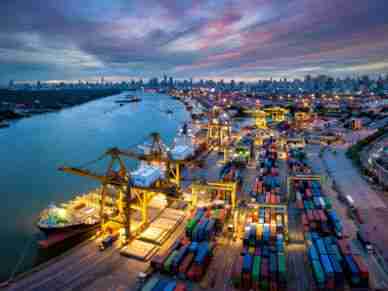
The ability to move goods quickly can make or break a company’s operations. Intermodal transportation is a flexible solution that allows organizations to enhance their supply chains, and the market for it is only growing.
What Is Intermodal Transportation?
Intermodal transportation is a system that integrates multiple shipping processes into one, including rail, truck, sea and air transportation. This method involves transferring standardized containers between transport modes, allowing businesses to maximize efficiency with multiple options.
Each mode has its advantages. When entities combine them, they retain flexible, cost-effective solutions for transporting freight across long distances.
In general, intermodal transportation is about optimization. For instance, a brand may take advantage of the efficiency of rail for the majority of a long-haul trip and then use trucks for the final mile. Doing so offers numerous benefits for delivering goods and has become the foundation of modern logistics.
The Intermodal Association of North America estimates the market to reach $40 billion, making it the largest transportation system in global supply chains. Industries that depend on high-volume shipping often turn to intermodal to improve their supply chain and keep pace with customer demands.
Benefits of Intermodal Transportation
Leveraging more than one mode of transportation for the shipment of goods offers several advantages necessary to support long-term growth.
1. Improved Supply Chain Resilience
One of the top benefits of intermodal transportation is the strength it brings to supply chains. By utilizing multiple modes of transport, corporations can diversify their shipping options and reduce disruptions.
Shipment delays can happen at any time, whether due to severe weather, port congestion or labor strikes. With one mode of transportation, there can be a serious disruption to operations. However, intermodal transportation ensures goods can still reach their destination by providing extra avenues of movement. In turn, companies can maintain continuity and avoid costly delays.
Additionally, intermodal transportation enables enterprises to build redundancy into their logistics strategies. For instance, rail and trucks can create alternative routes to bypass congestion points. This ensures that even if one mode faces setbacks, goods can continue to move smoothly via another channel.
2. Cost Efficiency
Intermodal transportation has a significant cost-saving potential, which is why many businesses use it to optimize their logistics operations. For long-haul segments, it can greatly reduce their overall shipping expenses. For example, many companies may use rail to lower operational spending because it requires less fuel and fewer drivers than highway transportation.
In turn, corporations may reduce costs by 10% to 40%, providing substantial savings. This is especially beneficial for organizations regularly transporting large volumes of goods over long distances. Rail may be more fuel-efficient, but it can also carry higher amounts of freight simultaneously, further driving down costs.
Moreover, intermodal transportation minimizes the inefficiencies of “empty miles” — the distance trucks travel without cargo. It optimizes routes, making better use of resources. As such, businesses can ensure they spend more of their fleet’s time moving freight rather than returning with empty loads. They can reinvest these savings into other areas of the supply chain, leading to a leaner and more financially efficient logistics network.
3. Environmental Sustainability
Sustainability becomes increasingly important in everyday operations, and intermodal transportation can be one way to reduce carbon footprint. Traditional road transport alone contributes heavily to greenhouse gas (GHG) emissions.
A typical vehicle emits 4.6 metric tons of carbon dioxide annually — 41% of emissions. Meanwhile, road transport for freight and cargo accounts for 29% of GHG emissions, creating a substantial impact on the environment.
By diversifying transport modes, companies can greatly reduce their emissions. For example, rail transport is far more energy-efficient and accounts for only 1% of greenhouse gas emissions. Furthermore, maritime shipping contributes 11% to global transport emissions. While this amount is higher than rail, it is much lower than road freight, making it a smaller environmental burden.
Reducing dependence on road transport is crucial in decreasing the global carbon footprint, and intermodal solutions make this transition smoother. When industries shift freight to more sustainable alternatives, they greatly reduce their overall carbon output. Taking such action helps establishments meet regulatory requirements and greener business practices.
4. Increased Flexibility and Scalability
Firms can achieve higher growth with intermodal transportation’s flexibility and scalability. This is because it allows them to adapt their logistics strategies to fluctuating demand, geographical challenges and shifting market conditions.
Trucks continue to dominate freight movement, handling $86.8 billion in goods — an increase of 8.4% compared to 2023. Their flexibility in managing first- and last-mile deliveries makes them indispensable for reaching urban centers and remote locations.
On the other hand, railways are ideal for long-haul segments, but the movement of freight in this mode has decreased by 6.8%. Despite the dip in rail freight, it still offers significant scalability, especially when moving more goods over long distances. Meanwhile, air freight provides fast turnaround times, which has increased by 12.3% from the previous year.
With several options for shipping goods, businesses become more adaptable in responding to market changes. For example, they can rely on trucks for last-mile deliveries when demand surges during peak season. Yet, if they need to ship more goods over long distances, they can always utilize rail or air.
Conversely, they can scale down operations as demand decreases, achieving more savings. When enterprises avoid committing to a single mode of transport, they have more freedom to optimize their logistics based on their specific needs.
5. Enhanced Customer Service and Satisfaction
Since intermodal transportation improves operational efficiency, organizations can serve customers more efficiently and retain their satisfaction. Using multiple modes of transport allows them to meet customer needs in several ways.
One significant advantage is the ability to offer faster deliveries. Intermodal transportation enhances flexibility in shipment processes so firms can optimize their routes to shorten transit times and meet customer expectations for faster shipping. In an age where speed is paramount, offering faster deliveries can garner customer loyalty.
Consistency in delivery is equally essential. Taking advantage of intermodal means businesses can create more reliable shipping schedules, which customers value. When brands consistently meet promised delivery times, it builds trust and strengthens relationships. For instance, it is possible to experience congestion on a highway, so switching road to rail ensures deliveries remain on time.
Leveraging Intermodal Transportation as a Pathway to Business Success
Intermodal transportation is an excellent solution for improving logistics, reducing expenses and enhancing overall operational efficiency. As logistics continues to evolve, enterprises should consider how they can maximize their shipments through multiple transport channels.
Whether the goal is to reduce emissions, cut costs or improve delivery times, rethinking their logistics strategy will be key to driving success.













Leave a Reply